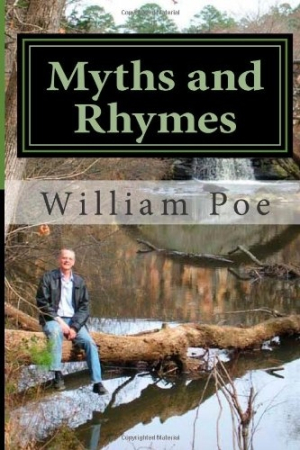Myths and Rhymes
In the introduction to Myths and Rhymes, poet William Poe encourages readers of his poetry collection to “allow the words to flow as much for their rhythm as for their meaning.” This is good advice to follow. The poems are clearly deeply personal, and their meaning often seems purposely obscured. When read aloud, however, no matter the meaning, it’s clear that these poems are meant to be heard. Most are about one-page long with tight stanzas and cadences, as in “Potter’s Field”: “Form a thought,/and live a day,/in stupid green,/with mold,/continuing on the path /—we’re told.”
Poe, who is also the author of two novels, Simon Says and Simple Simon, and a painter and sculptor, notes in the introduction that he finds poetic inspiration by jotting down his thoughts while in drug rehab. He was also once a member of the Unification Church, or a Moonie as they were called. Religious imagery permeates some of his poems, as do images from Greek mythology. He invokes Tartarus, an ancient torture chamber of the gods; the River Styx; and Charon, the ferryman to the underworld of Hades. His work shows a broad range of interests, and those who esteem the work of William S. Burroughs might enjoy Poe’s writing.
The collection doesn’t seem to be organized in any obviously thematic way, nor is it divided into parts. Titles are simply the first line of each poem.
The most common question raised by these poems is, “What are they about?” Themes of redemption, abandonment, and suppression of true feelings related to sexual desire reoccur. Knowing what or whom many of the poems are about can be tricky—Poe often leaves out definite and indefinite articles as well as personal pronouns. His strongest poems are addressed to “you” or “we” and have a clear subject. They’re also easiest to relate to and comprehend.
“Wasn’t It Fun?” is a remembrance of a life pushed to exhilarating limits: “Wasn’t it fun?/The slow dying,/that incredible last breath?/We tested the holy water /until the final edge.” This poem has a focus that’s understandable and ideas behind it that the reader can pinpoint. It’s more than an assortment of images ostensibly thrown together, which is how some poems in the collection seem.
Reading this poetry brings to mind fundamental questions asked in poetics seminars; What is the purpose of poetry? Is the poet responsible for leading readers to a certain conclusion of meaning? Or is it better to leave that meaning wide open for interpretation? Certainly, the act of creating a poem, of choosing each word and setting it down next to another chosen word, affects the way readers interpret the work as a whole. Meaning and rhythm can go hand in hand in poetry, and really they should. Still, asking the questions Poe’s uneven but heartfelt poems raise is a stimulating intellectual exercise.
Reviewed by
Olivia Boler
Disclosure: This article is not an endorsement, but a review. The publisher of this book provided free copies of the book and paid a small fee to have their book reviewed by a professional reviewer. Foreword Reviews and Clarion Reviews make no guarantee that the publisher will receive a positive review. Foreword Magazine, Inc. is disclosing this in accordance with the Federal Trade Commission’s 16 CFR, Part 255.


